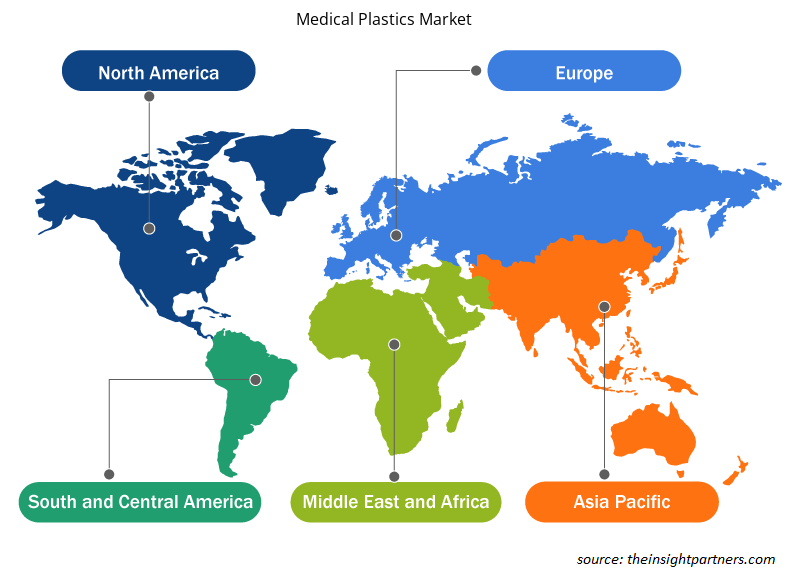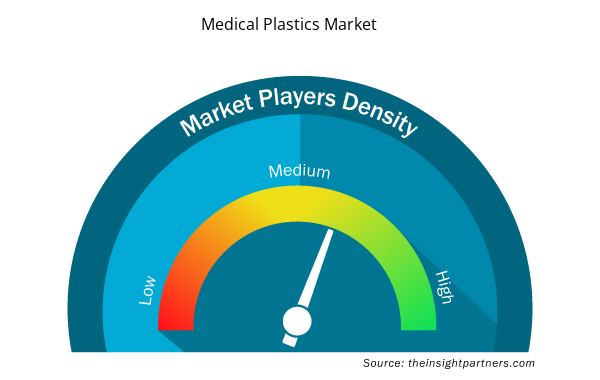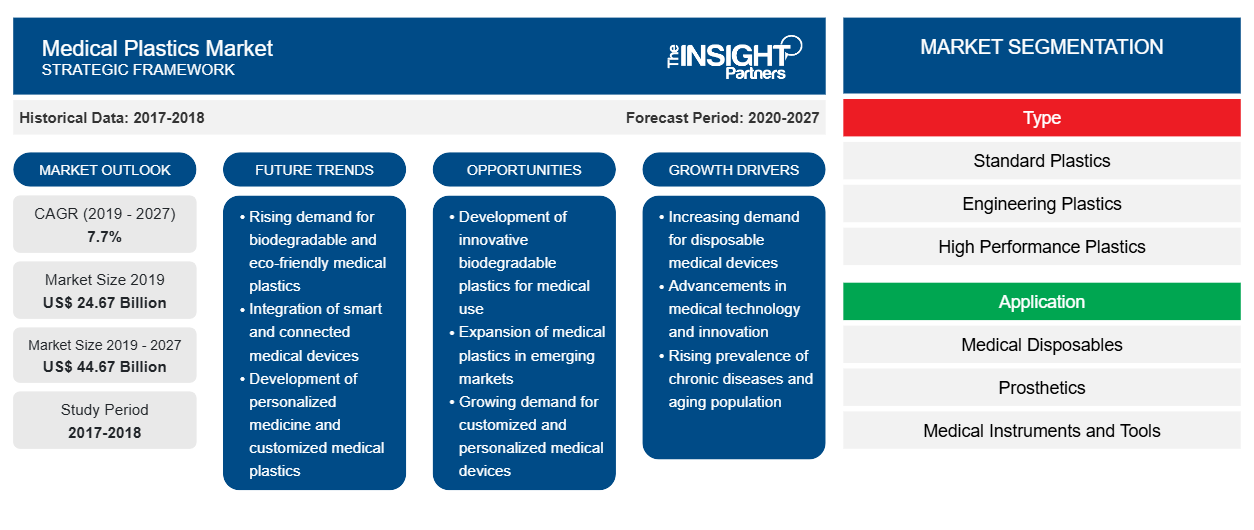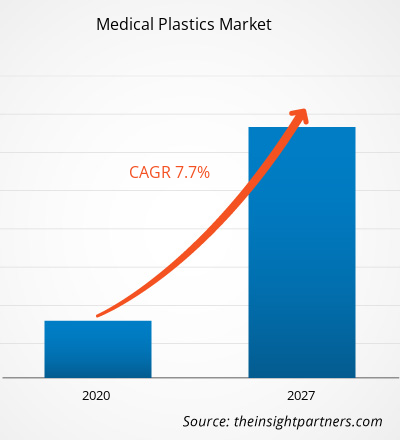Nel 2019, il mercato della plastica medica era valutato 24.671,82 milioni di dollari USA e si prevede che raggiungerà i 44.669,63 milioni di dollari USA entro il 2027; si prevede una crescita a un CAGR del 7,7% dal 2020 al 2027.
Le plastiche mediche sono realizzate con un numero enorme di macromolecole . Queste plastiche sono utilizzate per produrre strumenti coerenti e sicuri nel settore sanitario. Sono notevolmente durevoli, flessibili ed economiche. Le prestazioni, la sterilità e la qualità dei dispositivi medici sono un fattore importante per l'espansione del mercato. Le plastiche mediche trovano un'ampia gamma di applicazioni in strumenti diagnostici, impianti, monouso, dispositivi di somministrazione di farmaci, strumenti chirurgici, siringhe e cateteri. Si prevede che la popolazione globale aumenterà nei prossimi anni. Con l'aumento della popolazione, malattie e infezioni si stanno diffondendo in modo dilagante attraverso diversi mezzi. La crescente popolazione geriatrica migliora ulteriormente lo sviluppo del settore sanitario.
Si prevede che il mercato globale delle plastiche mediche nell'area Asia-Pacifico crescerà al CAGR più alto dell'8,4% nel periodo 2020-2027. La rapida crescita del mercato in questa regione è attribuita principalmente alla crescente domanda di plastiche mediche dovuta alle sue applicazioni in articoli monouso medici, protesi , strumenti e utensili medici e somministrazione di farmaci.
La recente epidemia di COVID-19, iniziata a Wuhan, in Cina, nel dicembre 2019, si è diffusa rapidamente in tutto il mondo. A giugno 2020, Stati Uniti, Russia, India, Cina, Italia, Francia e Germania sono tra i paesi più colpiti in termini di casi positivi e decessi segnalati. Secondo i dati dell'OMS aggiornati a giugno 2020, sono stati segnalati circa 7.482.952 casi confermati e circa 419.497 decessi a livello globale. L'epidemia ha colpito economie e industrie a causa di lockdown , divieti di viaggio e chiusure aziendali decretate in diversi paesi. I prodotti chimici e i materiali sono una delle principali industrie al mondo. Sta subendo gravi interruzioni, come interruzioni della catena di fornitura, cancellazioni di eventi tecnologici e chiusure di uffici, a seguito di questa epidemia. La Cina è il polo manifatturiero globale e il più grande fornitore di materie prime per vari settori. La sospensione di vari impianti e fabbriche in Cina sta influenzando le catene di fornitura globali e ha un impatto negativo sulla produzione e sulle vendite di vari prodotti chimici e materiali. Il crollo generale del mercato dovuto alla pandemia di COVID-19 sta influenzando anche la crescita del mercato globale della plastica medicale.
Personalizza questo report in base alle tue esigenze
Riceverai la personalizzazione gratuita di qualsiasi report, comprese parti di questo report, o analisi a livello nazionale, pacchetto dati Excel, oltre a usufruire di grandi offerte e sconti per start-up e università
- Scopri le principali tendenze di mercato in questo rapporto.Questo campione GRATUITO includerà analisi di dati che spaziano dalle tendenze di mercato alle stime e alle previsioni.
Approfondimenti di mercato
Numerosi vantaggi offerti dalla plastica nei dispositivi medici favoriscono la crescita del mercato a livello globale
Siringhe monouso in plastica, nuove valvole cardiache, sacche per il sangue e diversi dispositivi medici sono realizzati in materiale plastico. Per competere con le crescenti preoccupazioni riguardo allo stafilococco aureo resistente alla meticillina e simili, sono stati sviluppati polimeri ad alta tecnologia, infezioni da stafilococco trasmesse in ospedale e plastiche antimicrobiche. Queste plastiche respingono e uccidono la maggior parte dei batteri, anche su superfici ad alto contatto, e prevengono le infezioni. Inoltre, le plastiche antimicrobiche hanno un'efficienza molto elevata nell'uccidere i batteri anche quando le superfici non vengono pulite regolarmente. In questo modo, l'uso di polimeri ad alta tecnologia e plastiche antimicrobiche nei dispositivi medici aiuta a ridurre il rischio di malattie per i pazienti. Grazie all'elevata resistenza agli urti e alla stabilità termica, le plastiche ingegneristiche stanno ampiamente sostituendo il legno o qualsiasi altro materiale utilizzato come manico per strumenti chirurgici. Inoltre, le plastiche necessitano di meno manutenzione e sterilizzazione meno frequente. I produttori stanno passando dal legno e dal metallo alle plastiche ingegneristiche come il POM grazie alle sue prestazioni superiori, al prezzo basso, alle proprietà non igroscopiche e alla buona lavorabilità.
Approfondimenti sulle applicazioni
In base all'applicazione, il mercato delle materie plastiche mediche è suddiviso in monouso medici, protesi, strumenti e utensili medici, somministrazione di farmaci e altri. Il segmento degli strumenti e degli utensili medici ha rappresentato la quota maggiore del mercato globale nel 2019. Le materie plastiche sono state ampiamente utilizzate per creare strumenti e strumenti medici, come siringhe, guanti chirurgici, penne per insulina, cateteri, tubi IV e split gonfiabili. Tali prodotti sono realizzati per un uso singolo e aiutano a evitare la diffusione di malattie pericolose eliminando la necessità di riutilizzare o sterilizzare un dispositivo. Le materie plastiche vengono inoltre utilizzate per creare superfici tattili antimicrobiche superiori che possono respingere microbi e altri batteri, riducendo così la diffusione di malattie pericolose.
Approfondimenti regionali sul mercato delle materie plastiche mediche
Le tendenze regionali e i fattori che influenzano il mercato delle materie plastiche mediche durante il periodo di previsione sono stati ampiamente spiegati dagli analisti di Insight Partners. Questa sezione discute anche i segmenti e la geografia del mercato delle materie plastiche mediche in Nord America, Europa, Asia Pacifico, Medio Oriente e Africa e America centrale e meridionale.

- Ottieni i dati specifici regionali per il mercato della plastica medica
Ambito del rapporto sul mercato delle materie plastiche mediche
| Attributo del report | Dettagli |
|---|---|
| Dimensioni del mercato nel 2019 | 24,67 miliardi di dollari USA |
| Dimensioni del mercato entro il 2027 | 44,67 miliardi di dollari USA |
| CAGR globale (2019 - 2027) | 7,7% |
| Dati storici | 2017-2018 |
| Periodo di previsione | 2020-2027 |
| Segmenti coperti | Per tipo
|
| Regioni e Paesi coperti | America del Nord
|
| Leader di mercato e profili aziendali chiave |
|
Densità degli attori del mercato: comprendere il suo impatto sulle dinamiche aziendali
Il mercato delle materie plastiche mediche sta crescendo rapidamente, spinto dalla crescente domanda degli utenti finali dovuta a fattori quali l'evoluzione delle preferenze dei consumatori, i progressi tecnologici e una maggiore consapevolezza dei benefici del prodotto. Con l'aumento della domanda, le aziende stanno ampliando le loro offerte, innovando per soddisfare le esigenze dei consumatori e capitalizzando sulle tendenze emergenti, il che alimenta ulteriormente la crescita del mercato.
La densità degli operatori di mercato si riferisce alla distribuzione di aziende o società che operano in un particolare mercato o settore. Indica quanti concorrenti (operatori di mercato) sono presenti in un dato spazio di mercato in relazione alle sue dimensioni o al valore di mercato totale.
Le principali aziende che operano nel mercato della plastica medicale sono:
- Società Celanese
- Società chimica Eastman
- Plastica GW
- Ortoplastica Ltd
- ARAN TEORANTA BIOMEDICA
Disclaimer : le aziende elencate sopra non sono classificate secondo un ordine particolare.

- Ottieni una panoramica dei principali attori del mercato delle materie plastiche mediche
Mercato delle materie plastiche mediche, per tipo
- Plastica standard
- Materie plastiche ingegneristiche
- Plastica ad alte prestazioni (HPP)
- Silicone
- Altri
Mercato delle materie plastiche mediche, per applicazione
- Monouso medicali
- Protesi
- Strumenti e utensili medici
- Consegna di farmaci
- Altri
Profili aziendali
- Società Celanese
- Società chimica Eastman
- Plastica GW
- Ortoplastica Ltd
- ARAN TEORANTA BIOMEDICA
- Roccolo
- SABICO
- Saint Gobain
- Solvay
- Giù
- Analisi storica (2 anni), anno base, previsione (7 anni) con CAGR
- Analisi PEST e SWOT
- Valore/volume delle dimensioni del mercato - Globale, regionale, nazionale
- Industria e panorama competitivo
- Set di dati Excel


- Fill Finish Manufacturing Market
- Portable Power Station Market
- Small Molecule Drug Discovery Market
- Electronic Health Record Market
- Precast Concrete Market
- Employment Screening Services Market
- Virtual Production Market
- Piling Machines Market
- Battery Testing Equipment Market
- Integrated Platform Management System Market

Report Coverage
Revenue forecast, Company Analysis, Industry landscape, Growth factors, and Trends

Segment Covered
This text is related
to segments covered.

Regional Scope
North America, Europe, Asia Pacific, Middle East & Africa, South & Central America

Country Scope
This text is related
to country scope.
Domande frequenti
The demand for several types for medical disposables for treatment and diagnosis purpose is increasing owing to cost-effectiveness and production efficiency. The demand has also upstaged as it reduces the risk of cross-contamination and infection to patients. Wound management products, diagnostic and laboratory disposables, dialysis disposables, incontinence products, respiratory supplies, sterilization supplies, non-woven disposables, disposable masks, disposable eye gear, disposable gloves are some of the medical disposable extensively used in the healthcare industry.
In 2019, the medical plastic market was predominant in North America at the global level. North America is an attractive market categorized by the increasing demand for medical plastics. The growing innovations for the application of medical plastic backed by purchasing power to buy high priced medical plastic is positively impacting the growth of medical plastics market.
Celanese Corporation, Eastman Chemical Company, GW Plastics, Orthoplastics Ltd, ARAN BIOMEDICAL TEORANTA, Rochling, SABIC, Saint-Gobain, Solvay, and Dow are among the major players in the global medical plastics market.
Trends and growth analysis reports related to Chemicals and Materials : READ MORE..
The List of Companies - Fresh Pear Market
- Celanese Corporation
- Eastman Chemical Company
- GW Plastics
- Orthoplastics Ltd
- ARAN BIOMEDICAL TEORANTA
- Rochling
- SABIC
- Saint-Gobain
- Solvay
- Dow
The Insight Partners performs research in 4 major stages: Data Collection & Secondary Research, Primary Research, Data Analysis and Data Triangulation & Final Review.
- Data Collection and Secondary Research:
As a market research and consulting firm operating from a decade, we have published and advised several client across the globe. First step for any study will start with an assessment of currently available data and insights from existing reports. Further, historical and current market information is collected from Investor Presentations, Annual Reports, SEC Filings, etc., and other information related to company’s performance and market positioning are gathered from Paid Databases (Factiva, Hoovers, and Reuters) and various other publications available in public domain.
Several associations trade associates, technical forums, institutes, societies and organization are accessed to gain technical as well as market related insights through their publications such as research papers, blogs and press releases related to the studies are referred to get cues about the market. Further, white papers, journals, magazines, and other news articles published in last 3 years are scrutinized and analyzed to understand the current market trends.
- Primary Research:
The primarily interview analysis comprise of data obtained from industry participants interview and answers to survey questions gathered by in-house primary team.
For primary research, interviews are conducted with industry experts/CEOs/Marketing Managers/VPs/Subject Matter Experts from both demand and supply side to get a 360-degree view of the market. The primary team conducts several interviews based on the complexity of the markets to understand the various market trends and dynamics which makes research more credible and precise.
A typical research interview fulfils the following functions:
- Provides first-hand information on the market size, market trends, growth trends, competitive landscape, and outlook
- Validates and strengthens in-house secondary research findings
- Develops the analysis team’s expertise and market understanding
Primary research involves email interactions and telephone interviews for each market, category, segment, and sub-segment across geographies. The participants who typically take part in such a process include, but are not limited to:
- Industry participants: VPs, business development managers, market intelligence managers and national sales managers
- Outside experts: Valuation experts, research analysts and key opinion leaders specializing in the electronics and semiconductor industry.
Below is the breakup of our primary respondents by company, designation, and region:

Once we receive the confirmation from primary research sources or primary respondents, we finalize the base year market estimation and forecast the data as per the macroeconomic and microeconomic factors assessed during data collection.
- Data Analysis:
Once data is validated through both secondary as well as primary respondents, we finalize the market estimations by hypothesis formulation and factor analysis at regional and country level.
- Macro-Economic Factor Analysis:
We analyse macroeconomic indicators such the gross domestic product (GDP), increase in the demand for goods and services across industries, technological advancement, regional economic growth, governmental policies, the influence of COVID-19, PEST analysis, and other aspects. This analysis aids in setting benchmarks for various nations/regions and approximating market splits. Additionally, the general trend of the aforementioned components aid in determining the market's development possibilities.
- Country Level Data:
Various factors that are especially aligned to the country are taken into account to determine the market size for a certain area and country, including the presence of vendors, such as headquarters and offices, the country's GDP, demand patterns, and industry growth. To comprehend the market dynamics for the nation, a number of growth variables, inhibitors, application areas, and current market trends are researched. The aforementioned elements aid in determining the country's overall market's growth potential.
- Company Profile:
The “Table of Contents” is formulated by listing and analyzing more than 25 - 30 companies operating in the market ecosystem across geographies. However, we profile only 10 companies as a standard practice in our syndicate reports. These 10 companies comprise leading, emerging, and regional players. Nonetheless, our analysis is not restricted to the 10 listed companies, we also analyze other companies present in the market to develop a holistic view and understand the prevailing trends. The “Company Profiles” section in the report covers key facts, business description, products & services, financial information, SWOT analysis, and key developments. The financial information presented is extracted from the annual reports and official documents of the publicly listed companies. Upon collecting the information for the sections of respective companies, we verify them via various primary sources and then compile the data in respective company profiles. The company level information helps us in deriving the base number as well as in forecasting the market size.
- Developing Base Number:
Aggregation of sales statistics (2020-2022) and macro-economic factor, and other secondary and primary research insights are utilized to arrive at base number and related market shares for 2022. The data gaps are identified in this step and relevant market data is analyzed, collected from paid primary interviews or databases. On finalizing the base year market size, forecasts are developed on the basis of macro-economic, industry and market growth factors and company level analysis.
- Data Triangulation and Final Review:
The market findings and base year market size calculations are validated from supply as well as demand side. Demand side validations are based on macro-economic factor analysis and benchmarks for respective regions and countries. In case of supply side validations, revenues of major companies are estimated (in case not available) based on industry benchmark, approximate number of employees, product portfolio, and primary interviews revenues are gathered. Further revenue from target product/service segment is assessed to avoid overshooting of market statistics. In case of heavy deviations between supply and demand side values, all thes steps are repeated to achieve synchronization.
We follow an iterative model, wherein we share our research findings with Subject Matter Experts (SME’s) and Key Opinion Leaders (KOLs) until consensus view of the market is not formulated – this model negates any drastic deviation in the opinions of experts. Only validated and universally acceptable research findings are quoted in our reports.
We have important check points that we use to validate our research findings – which we call – data triangulation, where we validate the information, we generate from secondary sources with primary interviews and then we re-validate with our internal data bases and Subject matter experts. This comprehensive model enables us to deliver high quality, reliable data in shortest possible time.


 Ottieni un campione gratuito per questo repot
Ottieni un campione gratuito per questo repot